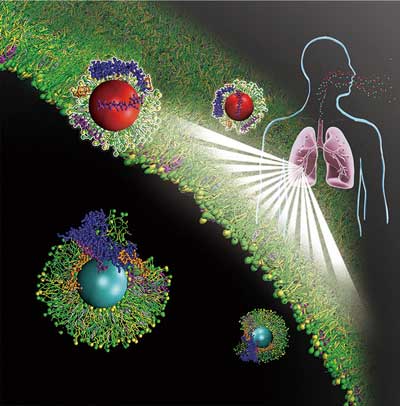| Posted: Aug 23, 2017 |
New biological identity of inhaled nanoparticles revealed
(Nanowerk News) Nano-enabled consumer products surround people everyday, from personal care, cosmetics, clothing and electronics, to food and beverage. However, their potential biological risks are still largely unknown.
|
|
University of Hawai'i at Manoa College of Engineering Professor Yi Zuo has developed a new method to reveal the molecular mechanism of nano-bio interactions in the lungs. This research was published in the July 2017 issue of the scientific journal ACS Nano ("Unveiling the Molecular Structure of Pulmonary Surfactant Corona on Nanoparticles").
|
 |
| Molecular dynamics simulations revealed a pulmonary surfactant corona coated on inhaled nanoparticles. This biomolecular corona determines the biological identity of the particles. (Image: Guoqing Hu and Yi Zuo)
|
|
Zuo’s study showed that once the inhaled nanoparticles enter the lungs, they are quickly wrapped with a biomolecular corona made of the natural pulmonary surfactant. The entire surface of the lungs is lined with a lipid-protein pulmonary surfactant film which serves an important physiological function of host defense and surface tension reduction. The pulmonary surfactant corona provides the inhaled nanoparticles with a new identity in their subsequent interactions with the biological system, such as their clearance and cellular toxicity.
|
|
“Molecular scale interactions between nanoparticles and biomolecules are too small and too fast to be visualized by most conventional experimental methods,” Zuo said. “Hence, we studied the nano-bio interactions with a virtual experiment called molecular dynamics simulations. Using supercomputers, we created a virtual box in which a certain number of molecules and particles can move and interact with each other for a certain time by following the natural laws of physics and chemistry. The final equilibrium state of the simulation reveals the molecular mechanism of nano-bio interactions.”
|
|
This study may also advance the understanding of other air pollutants, such as vog, an air pollutant that is unique to Hawai?i. Given the environmental, health and safety impact of vog, there is an urgent need to understand its pulmonary risk, especially to those with existing respiratory conditions and children, whose respiratory system is significantly more vulnerable to particle invasion than adults.
|
|
Zuo is continuing to study the molecular mechanism of nano-bio interactions using molecular dynamics simulations and novel experimental techniques developed in his Laboratory of Biocolloids and Biointerfaces, helping to provide a useful metric for regulating and overseeing commercial applications of nanotechnology toward a safer and more sustainable development.
|

